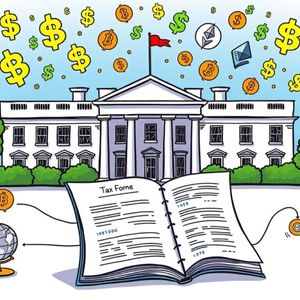BitcoinWorld Crucial Shift: Traders Scale Back Bets on Multiple Fed Rate Cuts The financial world is abuzz with a significant shift in market sentiment. What was once a strong conviction among traders – the expectation of multiple Fed rate cuts this year – has notably diminished. According to the widely followed Walter Bloomberg economic news account on X, the collective bets on more than one interest rate reduction from the Federal Reserve have declined. For anyone invested in the dynamic world of cryptocurrencies, this isn’t just a headline; it’s a signal that could reshape market strategies and investor expectations. But what exactly does this mean for your portfolio, and why are traders suddenly rethinking their positions? Why the Retreat from Multiple Fed Rate Cuts? For months, market participants eagerly anticipated a series of aggressive Fed rate cuts , hoping for a return to looser monetary conditions that typically fuel risk-on assets like cryptocurrencies. This optimism was largely driven by projections of cooling inflation and a potential economic slowdown. However, recent economic data and Federal Reserve communications have painted a different picture, prompting a significant recalibration of these expectations. Several key factors contribute to this shift: Persistent Inflation: While inflation has moderated, it has proven stickier than many predicted. The Federal Reserve’s primary mandate includes price stability, and current inflation levels remain above the Fed’s 2% target. This persistence reduces the urgency for the Fed to ease monetary policy. Robust Job Market: The U.S. labor market has consistently defied expectations of a slowdown. Strong job growth and low unemployment rates suggest a resilient economy that can withstand higher interest rates for longer, lessening pressure for cuts to stimulate employment. Strong Economic Growth: Contrary to recession fears, the U.S. economy has demonstrated surprising strength. GDP figures have often exceeded forecasts, indicating underlying economic momentum. This strength allows the Fed to maintain a restrictive stance without immediately risking a severe downturn. Federal Reserve’s Cautious Stance: Fed officials, including Chairman Jerome Powell, have repeatedly emphasized a data-dependent approach and a commitment to ensuring inflation is firmly on a path back to 2%. Their recent public statements have conveyed a “higher for longer” message, indicating a reluctance to cut rates prematurely and risk a resurgence of inflationary pressures. The market is now listening more closely to this cautious rhetoric. Essentially, the narrative has shifted from “when will the Fed cut rates?” to “will the Fed cut rates as much as we thought?” The data suggests that the economic conditions allowing for multiple, rapid Fed rate cuts are not yet fully in place, leading traders to adjust their outlook accordingly. The Ripple Effect: How Fed Rate Cuts Influence Crypto Markets Understanding the Federal Reserve’s monetary policy is crucial for cryptocurrency investors because interest rates profoundly influence capital flows and investor sentiment. The prospect of fewer Fed rate cuts has direct and indirect implications for digital assets: Direct Impacts: Cost of Capital: Higher interest rates increase the cost of borrowing for businesses and individuals. For crypto companies, this can mean more expensive financing. For investors, the opportunity cost of holding non-yielding assets like cryptocurrencies increases when safer, interest-bearing investments offer attractive returns. Dollar Strength: When U.S. interest rates are higher relative to other major economies, the U.S. dollar tends to strengthen. A stronger dollar can make dollar-denominated assets, including cryptocurrencies, less appealing to international investors. Indirect Impacts (Sentiment & Risk Appetite): Risk-On/Risk-Off Dynamics: Cryptocurrencies are generally considered risk-on assets. In an environment of lower interest rates and abundant liquidity, investors are more willing to take on risk. Conversely, when rates are high and liquidity tight, a “risk-off” sentiment prevails, leading investors to move towards safer assets. The reduced expectation of multiple Fed rate cuts signals a continuation of a tighter financial environment, dampening risk appetite. Liquidity: Fewer rate cuts mean less new money flowing into the system, which can reduce the capital available for speculative investments, including cryptocurrencies. A tighter liquidity environment can constrain upward price movements. Institutional Investment: Large institutional investors often consider macroeconomic conditions. A prolonged period of higher rates or economic uncertainty might lead them to delay or reduce their exposure to nascent and volatile asset classes like crypto, preferring more established and less risky investments. Historically, periods of quantitative easing and low interest rates have coincided with significant bull runs in the crypto market, while periods of tightening have often preceded or accompanied downturns. While correlation is not causation, the relationship between macro policy and crypto performance is a significant factor many traders consider. Navigating Market Uncertainty: Actionable Insights Amidst Shifting Fed Rate Cut Expectations In a landscape where the path of Fed rate cuts is less certain, investors must adapt their strategies to mitigate risks and capitalize on potential opportunities. Here are some actionable insights: Stay Informed and Agile: The macroeconomic environment is dynamic. Keep a close eye on key economic indicators (inflation reports, jobs data, GDP figures) and Federal Reserve communications. Being agile means being prepared to adjust your positions based on new information. Re-evaluate Risk Tolerance: With potentially higher-for-longer interest rates, the risk premium for volatile assets like cryptocurrencies might increase. Re-assess your personal risk tolerance and ensure your portfolio allocation aligns with it. Focus on Fundamentals: In uncertain times, projects with strong fundamentals, clear utility, robust technology, and sustainable tokenomics tend to fare better. Focus on deep research into the underlying value proposition of crypto assets. Consider Dollar-Cost Averaging (DCA): Rather than attempting to time the market, consider implementing a dollar-cost averaging strategy. This involves investing a fixed amount of money at regular intervals, regardless of price fluctuations, which can help mitigate volatility. Explore Yield Opportunities: In a higher interest rate environment, exploring legitimate yield-generating opportunities within the crypto space (e.g., staking, DeFi lending on reputable platforms) might become more attractive, always with a thorough understanding of the associated risks. Diversification: While cryptocurrencies can offer significant returns, diversifying your portfolio across different asset classes (e.g., traditional stocks, bonds, real estate, and various crypto sectors) can help reduce overall risk. The key is to approach the market with a well-thought-out plan, rather than reacting impulsively to every news headline about Fed rate cuts or economic data point. What’s Next for Fed Rate Cuts? Key Indicators to Watch While traders have scaled back their immediate expectations for aggressive Fed rate cuts , the possibility of future reductions remains on the table. The Federal Reserve’s decisions are primarily data-driven, meaning their path forward will be dictated by how the economy evolves. Here are the critical indicators and events that market participants will be scrutinizing: Inflation Data (CPI & PCE): Consistent declines in these figures, especially core inflation, towards the 2% target would be the strongest signal for potential rate cuts. Employment Reports: A significant weakening in the job market, such as sustained job losses or a sharp rise in unemployment, could prompt the Fed to consider easing policy. Consumer Spending & Retail Sales: A notable slowdown in spending could indicate a weakening economy, increasing the likelihood of rate adjustments. Federal Reserve Speeches & Meeting Minutes: Direct communications from Fed officials offer invaluable insights into their thinking, concerns, and future policy intentions regarding Fed rate cuts . The market will be a constant dance between incoming economic data and the Fed’s response. Investors should prepare for continued volatility and be ready to adapt their strategies as new information emerges regarding the trajectory of Fed rate cuts . Conclusion: Navigating the Evolving Landscape of Fed Rate Cuts The recent recalibration of expectations for multiple Fed rate cuts marks a significant moment for financial markets, particularly for the often-volatile cryptocurrency space. It underscores the Federal Reserve’s commitment to taming inflation, even if it means maintaining higher interest rates for an extended period. For traders and investors, this shift is a powerful reminder of the interconnectedness of macroeconomic policy and asset performance. While the immediate outlook for aggressive rate reductions has dimmed, the market remains fluid. Success in this evolving environment will hinge on a combination of informed decision-making, strategic adaptation, and a deep understanding of how global economic forces, particularly central bank policies, shape investment opportunities. By staying vigilant, focusing on fundamentals, and managing risk effectively, participants can better navigate the complexities and position themselves for long-term success, regardless of the precise timing or magnitude of future Fed rate cuts . Frequently Asked Questions (FAQs) 1. What are Fed rate cuts? Fed rate cuts refer to the Federal Reserve’s decision to lower the target range for the federal funds rate, which is the interest rate at which commercial banks lend to each other overnight. Lowering this rate makes borrowing cheaper for banks, businesses, and consumers, aiming to stimulate economic activity, increase liquidity, and encourage investment. 2. Why did traders initially expect multiple Fed rate cuts this year? Initially, traders anticipated multiple Fed rate cuts based on projections of cooling inflation, potential economic slowdowns, and the historical tendency of the Fed to ease policy after periods of aggressive tightening. Many believed the Fed would pivot quickly to support growth once inflation showed clear signs of declining. 3. How do fewer Fed rate cuts impact the cryptocurrency market? Fewer Fed rate cuts generally create a “higher for longer” interest rate environment. This can negatively impact the cryptocurrency market by increasing the cost of capital, strengthening the U.S. dollar, and fostering a “risk-off” sentiment where investors prefer safer assets over volatile ones like crypto. It also reduces overall market liquidity, which can constrain price appreciation. 4. What economic indicators should I watch regarding future Fed rate cuts? Key indicators to watch include inflation data (CPI, PCE), employment reports (Non-Farm Payrolls, unemployment rate, wage growth), GDP figures, consumer spending, and manufacturing/services PMIs. Additionally, pay close attention to official statements and meeting minutes from the Federal Reserve. 5. Is it still possible the Fed will implement multiple rate cuts this year? While current market expectations have significantly scaled back, it’s not impossible. The Federal Reserve’s policy is data-dependent. If economic conditions deteriorate unexpectedly – for example, a sharp rise in unemployment or a rapid and sustained decline in inflation – the Fed could still opt for more aggressive easing, including multiple Fed rate cuts . Did this article shed light on the complex interplay between Fed policy and market dynamics? Share your thoughts and help others understand these crucial shifts by sharing this article on your social media platforms! Your insights can spark important conversations. To learn more about the latest explore our article on key developments shaping the crypto market’s future price action. This post Crucial Shift: Traders Scale Back Bets on Multiple Fed Rate Cuts first appeared on BitcoinWorld and is written by Editorial Team















